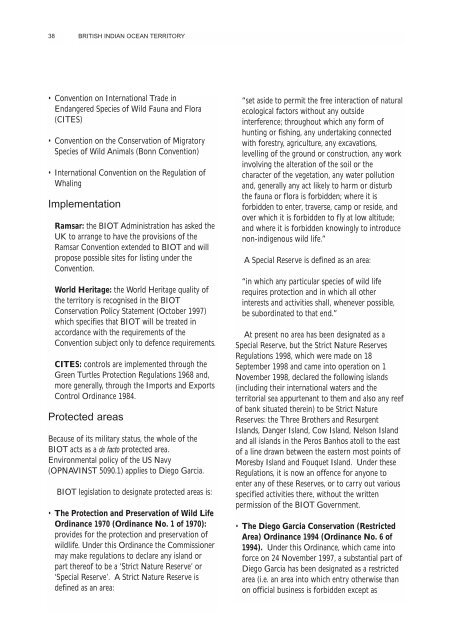Biodiversity: the UK Overseas Territories - WIDECAST
Biodiversity: the UK Overseas Territories - WIDECAST
Biodiversity: the UK Overseas Territories - WIDECAST
Create successful ePaper yourself
Turn your PDF publications into a flip-book with our unique Google optimized e-Paper software.
38 BRITISH INDIAN OCEAN TERRITORY<br />
• Convention on International Trade in<br />
Endangered Species of Wild Fauna and Flora<br />
(CITES)<br />
• Convention on <strong>the</strong> Conservation of Migratory<br />
Species of Wild Animals (Bonn Convention)<br />
• International Convention on <strong>the</strong> Regulation of<br />
Whaling<br />
Implementation<br />
Ramsar: <strong>the</strong> BIOT Administration has asked <strong>the</strong><br />
<strong>UK</strong> to arrange to have <strong>the</strong> provisions of <strong>the</strong><br />
Ramsar Convention extended to BIOT and will<br />
propose possible sites for listing under <strong>the</strong><br />
Convention.<br />
World Heritage: <strong>the</strong> World Heritage quality of<br />
<strong>the</strong> territory is recognised in <strong>the</strong> BIOT<br />
Conservation Policy Statement (October 1997)<br />
which specifies that BIOT will be treated in<br />
accordance with <strong>the</strong> requirements of <strong>the</strong><br />
Convention subject only to defence requirements.<br />
CITES: controls are implemented through <strong>the</strong><br />
Green Turtles Protection Regulations 1968 and,<br />
more generally, through <strong>the</strong> Imports and Exports<br />
Control Ordinance 1984.<br />
Protected areas<br />
Because of its military status, <strong>the</strong> whole of <strong>the</strong><br />
BIOT acts as a de facto protected area.<br />
Environmental policy of <strong>the</strong> US Navy<br />
(OPNAVINST 5090.1) applies to Diego Garcia.<br />
BIOT legislation to designate protected areas is:<br />
• The Protection and Preservation of Wild Life<br />
Ordinance 1970 (Ordinance No. 1 of 1970):<br />
provides for <strong>the</strong> protection and preservation of<br />
wildlife. Under this Ordinance <strong>the</strong> Commissioner<br />
may make regulations to declare any island or<br />
part <strong>the</strong>reof to be a ‘Strict Nature Reserve’ or<br />
‘Special Reserve’. A Strict Nature Reserve is<br />
defined as an area:<br />
“set aside to permit <strong>the</strong> free interaction of natural<br />
ecological factors without any outside<br />
interference; throughout which any form of<br />
hunting or fishing, any undertaking connected<br />
with forestry, agriculture, any excavations,<br />
levelling of <strong>the</strong> ground or construction, any work<br />
involving <strong>the</strong> alteration of <strong>the</strong> soil or <strong>the</strong><br />
character of <strong>the</strong> vegetation, any water pollution<br />
and, generally any act likely to harm or disturb<br />
<strong>the</strong> fauna or flora is forbidden; where it is<br />
forbidden to enter, traverse, camp or reside, and<br />
over which it is forbidden to fly at low altitude;<br />
and where it is forbidden knowingly to introduce<br />
non-indigenous wild life.”<br />
A Special Reserve is defined as an area:<br />
“in which any particular species of wild life<br />
requires protection and in which all o<strong>the</strong>r<br />
interests and activities shall, whenever possible,<br />
be subordinated to that end.”<br />
At present no area has been designated as a<br />
Special Reserve, but <strong>the</strong> Strict Nature Reserves<br />
Regulations 1998, which were made on 18<br />
September 1998 and came into operation on 1<br />
November 1998, declared <strong>the</strong> following islands<br />
(including <strong>the</strong>ir international waters and <strong>the</strong><br />
territorial sea appurtenant to <strong>the</strong>m and also any reef<br />
of bank situated <strong>the</strong>rein) to be Strict Nature<br />
Reserves: <strong>the</strong> Three Bro<strong>the</strong>rs and Resurgent<br />
Islands, Danger Island, Cow Island, Nelson Island<br />
and all islands in <strong>the</strong> Peros Banhos atoll to <strong>the</strong> east<br />
of a line drawn between <strong>the</strong> eastern most points of<br />
Moresby Island and Fouquet Island. Under <strong>the</strong>se<br />
Regulations, it is now an offence for anyone to<br />
enter any of <strong>the</strong>se Reserves, or to carry out various<br />
specified activities <strong>the</strong>re, without <strong>the</strong> written<br />
permission of <strong>the</strong> BIOT Government.<br />
• The Diego Garcia Conservation (Restricted<br />
Area) Ordinance 1994 (Ordinance No. 6 of<br />
1994). Under this Ordinance, which came into<br />
force on 24 November 1997, a substantial part of<br />
Diego Garcia has been designated as a restricted<br />
area (i.e. an area into which entry o<strong>the</strong>rwise than<br />
on official business is forbidden except as
















